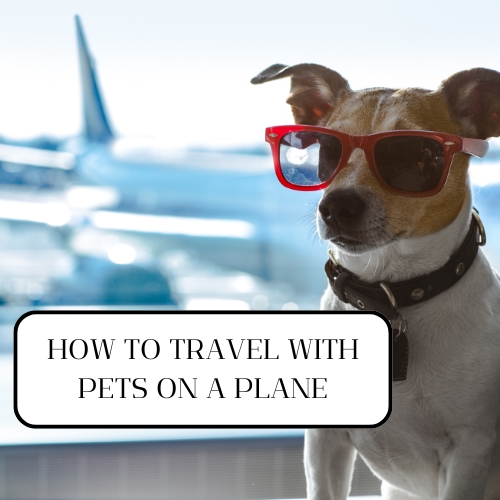How to Travel with Pets on a Plane: A Comprehensive Guide for Pet Owners
Traveling with pets on a plane can be an exciting but challenging experience. Whether you’re moving to a new city, going on vacation, or traveling for work, ensuring your pet’s comfort and safety during the journey is crucial. In this guide, we’ll walk you through everything you need to know about how to travel with pets on a plane – from preparation, booking, and in-flight tips to handling any unexpected issues.
1. Research Airline Pet Policies
The first step in preparing for air travel with your pet is to thoroughly research the pet policies of different airlines. Each airline has specific rules regarding the size of pets allowed in the cabin or cargo, types of carriers required, and fees involved. Some important points to consider:
- Cabin vs. Cargo: Most airlines allow small pets (typically under 20 lbs, including the carrier) to travel in the cabin. Larger pets usually need to be checked in as cargo. Always confirm if your pet can fly in the cabin to avoid last-minute surprises.
- Breed Restrictions: Certain airlines have restrictions on breeds, especially snub-nosed dogs like pugs and bulldogs, due to their breathing difficulties at high altitudes.
- Fees: Most airlines charge an additional fee for pets, which can range from $50 to $200 depending on the route and the size of the pet.
2. Visit the Veterinarian
Before traveling, schedule a vet visit to ensure your pet is healthy enough to fly. You’ll need to obtain a health certificate from your vet, which is usually required by airlines and may also be needed for international travel. During the visit, ask the vet for advice on calming your pet if they tend to get anxious during travel. Some tips for the vet visit include:
- Vaccinations: Make sure your pet is up-to-date on all vaccinations.
- Medications: Ask your vet about any medications that might help reduce anxiety or nausea during the flight.
- Microchip and ID Tag: Ensure your pet has a microchip and is wearing an updated ID tag with your contact details in case they get lost.
3. Choose the Right Carrier
The right carrier is essential for your pet’s comfort and safety during the flight. Make sure to choose a carrier that meets airline regulations and is comfortable for your pet. Here are some tips:
- Cabin-approved Carrier: If your pet is traveling in the cabin, the carrier must fit under the seat in front of you. It should be well-ventilated and spacious enough for your pet to stand, turn around, and lie down.
- Cargo-approved Crate: If your pet must travel in cargo, choose a crate that is sturdy, secure, and large enough for your pet. It should have good ventilation and a leak-proof bottom.
- Familiarization: A few weeks before the trip, let your pet get used to the carrier by placing them in it for short periods. This helps reduce anxiety on the day of travel.
4. Book Your Flight Early
Airlines often have limited space for pets in the cabin, so it’s important to book your flight early and reserve a spot for your pet. When booking, choose a flight with the following in mind:
- Direct Flights: Whenever possible, opt for a direct flight to minimize the stress on your pet. Layovers can be long and confusing, which can add to your pet’s anxiety.
- Weather Conditions: If your pet is traveling in cargo, consider the weather. Avoid booking flights during extreme heat or cold as these conditions can be dangerous for pets, especially in the cargo hold.
5. Prepare for International Travel
If you’re flying internationally with your pet, the process can be more complex due to additional documentation and quarantine requirements. Every country has its own regulations for pet entry, so it’s crucial to research the destination’s pet import rules well in advance. Important considerations include:
- Pet Passport: Some countries, especially within the EU, require a pet passport showing proof of vaccinations and health certificates.
- Quarantine: Certain countries have quarantine requirements for pets. Research if your destination has any such rules and plan accordingly.
- Customs Regulations: Be aware of customs requirements, as some destinations require additional paperwork or inspections for pets.
6. Packing Essentials for Your Pet
Just like packing for yourself, it’s essential to pack for your pet to ensure they have everything they need for a smooth journey. Key items to pack include:
- Pet Carrier: Ensure it meets airline regulations.
- Food and Water: Pack enough food for the journey, plus an extra day’s worth just in case of delays.
- Collapsible Bowls: These are space-saving and convenient for feeding and watering your pet.
- Leash and Harness: Even if your pet is in a carrier, a leash and harness are useful for walking them before and after the flight.
- Favorite Toy or Blanket: Something familiar can help soothe your pet during the flight.
- Waste Bags and Pads: For bathroom emergencies during long flights.
- Health Documents: Keep all vet records, including vaccination certificates and health certificates, in an easily accessible place.
7. Pre-flight Preparation
On the day of travel, pre-flight preparation is essential for a smooth experience. A few hours before the flight, take your pet for a long walk or play with them to tire them out. This helps reduce their energy levels, making them calmer during the flight.
- Avoid Feeding Right Before the Flight: To prevent any accidents, avoid feeding your pet a large meal 4-6 hours before departure.
- Hydration: Ensure your pet is well-hydrated but avoid giving them too much water immediately before the flight.
8. At the Airport
Once you arrive at the airport, check in early to allow extra time for processing your pet’s travel. Most airlines require you to check in pets at a special desk, especially for pets traveling in cargo. During security checks, you will likely need to remove your pet from their carrier, so it’s helpful to have a leash handy.
- Check-in: Arrive early to complete all necessary pet-related paperwork.
- Security: Be prepared to take your pet out of the carrier for TSA screening.
9. During the Flight
During the flight, it’s important to keep your pet as calm as possible. If your pet is in the cabin with you, keep the carrier under the seat and avoid opening it unless absolutely necessary. If your pet is in cargo, ask the flight crew to confirm that your pet has been safely loaded onto the plane.
- Stay Calm: Pets can sense your anxiety, so staying calm will help your pet remain calm too.
- Check on Your Pet: If possible, check on your pet during layovers or before boarding to ensure they’re comfortable.
10. Post-flight Care
After landing, check on your pet as soon as possible. For pets traveling in cargo, retrieve them immediately from the cargo area. Give them time to stretch, drink water, and relieve themselves. Also, monitor them for signs of stress or fatigue.
- Post-flight Walk: Give your pet a walk after the flight to help them relax.
- Hydrate: Offer water and a light meal once your pet has settled down.
11. Handling Emergencies
Despite careful planning, things can go wrong. Knowing how to handle emergencies while traveling with pets is crucial. Keep the contact information of veterinary services at your destination handy, and make sure you know the procedures if your pet becomes ill during the journey.
- Vet Access: Identify local vets at your destination in case of emergencies.
- Pet Insurance: Consider purchasing pet travel insurance for added peace of mind.
Conclusion
Traveling with pets on a plane can be a rewarding experience when properly planned. By researching airline policies, preparing the right carrier, packing essentials, and ensuring your pet’s comfort throughout the journey, you can make air travel a smooth and enjoyable experience for both you and your furry friend. Whether traveling domestically or internationally, following these steps will help ensure that your pet arrives at your destination safe, happy, and ready for adventure.

